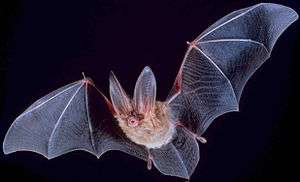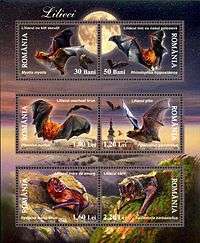Microbat
| Microbats | |
|---|---|
 | |
| Townsend's big-eared bat, Corynorhinus townsendii | |
| Scientific classification | |
| Kingdom: | Animalia |
| Phylum: | Chordata |
| Class: | Mammalia |
| Order: | Chiroptera |
| Suborder: | Microchiroptera Dobson, 1875 |
| Superfamilies | |
|
Emballonuroidea | |
The microbats constitute the now outdated suborder Microchiroptera within the order Chiroptera (bats). Bats were once differentiated into Megachiroptera and Microchiroptera, based on their size; but available molecular evidence has now shown this to be incorrect, the horseshoe bats being included in Yinpterochiroptera with the fruit bats and others. Most species which were termed Microchiroptera are now referred to as the Yangochiroptera.
Definition
The distinctions between microbats and megabats are:
- Microbats use echolocation, whereas megabats do not typically. (The Egyptian fruit bat Rousettus egyptiacus is an exception, but does not use the larynx echolocation method of microbats, instead giving scientists the theory that it clicks using its nasal passages and back of its tongue.)
- Microbats lack the claw at the second finger of the forelimb. This finger appears thinner and almost bonded by tissue with the third finger for extra support during flight.
- Megabats always lack a tail, whereas this trait only occurs in certain species of microbats.
- The ears of microbats possess a tragus (thought to be crucial in echolocation) and are respectively larger than megabat ears, whereas megabat ears are comparatively small and lack a tragus.
- Megabat eyes are quite large, whereas microbat eyes are comparatively smaller.
Characteristics
Microbats are 4 to 16 cm long.[1]
Most microbats feed on insects. Some of the larger species hunt birds, lizards, frogs, smaller bats or even fish.
The only three species of microbat that feed on the blood of large mammals or birds ("vampire bats") live in South and Central America.
The term "leaf-nose" does not indicate the diet preferred by particular species and is applied to a wide variety of microbats.[2] Most leaf-nosed microbat species are fruit and nectar-eating. However, three species follow the bloom of columnar cacti in northwest Mexico and the Southwest United States northward in the northern spring and then the blooming agaves southward in the northern fall (autumn).[3] Other leaf-nosed bats, such as Vampyrum spectrum of South America, hunt a variety of prey such as lizards and birds. The horseshoe bats of Europe and California leaf-nosed bat have an incredibly intricate leaf-nose for echolocation and feed primarily on insects.
Echolocation
Microbats generate ultrasound via the larynx and emit the sound through the nose or the open mouth. Microbat ![]() calls range in frequency from 14,000 to over 100,000 hertz, well beyond the range of the human ear (typical human hearing range is considered to be from 20 to 20,000 Hz). The emitted vocalizations form a broad beam of sound used to probe the environment, as well as communicate with other bats.
calls range in frequency from 14,000 to over 100,000 hertz, well beyond the range of the human ear (typical human hearing range is considered to be from 20 to 20,000 Hz). The emitted vocalizations form a broad beam of sound used to probe the environment, as well as communicate with other bats.
Some moths have developed a protection against bats. They are able to hear bats' ultrasounds and flee as soon as they notice these sounds, or stop beating their wings for some time to deprive the bats of the characteristic echo signature of moving wings on which they may home in. To counteract this, the bats may cease producing the ultrasound bursts as they near prey, and thus avoid detection.
Classification

While bats have been traditionally divided into megabats and microbats, recent molecular evidence has shown the superfamily Rhinolophoidea to be more genetically related to megabats than to microbats, indicating the microbats are paraphyletic. To resolve the paraphyly of microbats, the Chiroptera were redivided into suborders Yangochiroptera (which includes Nycteridae, vespertilionoids, noctilionoids, and emballonuroids) and Yinpterochiroptera, which includes megabats, rhinopomatids, Rhinolophidae, and Megadermatidae.[4]
This is the classification according to Simmons and Geisler (1998):
Superfamily Emballonuroidea
- Family Emballonuridae (sac-winged bats or sheath-tailed bats)
Superfamily Rhinopomatoidea
- Family Rhinopomatidae (mouse-tailed bats)
- Family Craseonycteridae (bumblebee bat or Kitti's hog-nosed bat)
Superfamily Rhinolophoidea
- Family Rhinolophidae (horseshoe bats)
- Family Nycteridae (hollow-faced bats or slit-faced bats)
- Family Megadermatidae (false vampires)
Superfamily Vespertilionoidea
- Family Vespertilionidae (vesper bats or evening bats)
Superfamily Molossoidea
- Family Molossidae (free-tailed bats)
- Family Antrozoidae (pallid bats)
Superfamily Nataloidea
- Family Natalidae (funnel-eared bats)
- Family Myzopodidae (sucker-footed bats)
- Family Thyropteridae (disk-winged bats)
- Family Furipteridae (smoky bats)
Superfamily Noctilionoidea
- Family Noctilionidae (bulldog bats or fisherman bats)
- Family Mystacinidae (New Zealand short-tailed bats)
- Family Mormoopidae (ghost-faced bats or moustached bats)
- Family Phyllostomidae (leaf-nosed bats)
References
- ↑ Whitaker, J.O. Jr, Dannelly, H.K. & Prentice, D.A. (2004) Chitinase in insectivorous bats. Journal of. Mammalogy, 85, 15–18.
- ↑ Walker's Bats of the World, Ronald M. Nowak (1994)
- ↑ A Natural History of the Sonoran Desert, Edited by Steven Phillips and Patricia Comus, University of California Press, Berkeley p. 464
- ↑ Teeling, E. C.; Madsen, O.; Van de Bussche, R. A.; de Jong, W. W.; Stanhope, M. J.; Springer, M. S. (2002). "Microbat paraphyly and the convergent evolution of a key innovation in Old World rhinolophoid microbats". Proceedings of the National Academy of Sciences of the United States of America. 99 (3): 1431–1436. doi:10.1073/Pnas.022477199.
External links
- Bat World Sanctuary
- Illustrated Identification key to the bats of Europe (see "Recent publications")
- Bat Conservation International
- View the myoLuc2 genome assembly in the UCSC Genome Browser.